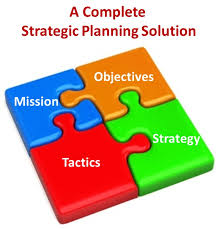Dani Robbins is the Founder & Principal Strategist at Non Profit Evolution located in Columbus, Ohio. I’ve invited my good friend and fellow non-profit consultant to the first Wednesday of each month about board development related topics. Dani also recently co-authored a book titled “Innovative Leadership Workbook for Nonprofit Executives” that you can find on Amazon.com.
Governance: The Work of the Board, part 5
Setting the Mission, Vision and Strategic Plan
By Dani Robbins
 Welcome to the final post in our five-part series on Governance. We have already discussed the Board’s role in Hiring, Supporting and Evaluating the Executive, Acting as the Fiduciary Responsible Agent, Setting Policy, and Raising Money. Today, let’s discuss the Board’s role in setting the mission, vision and strategic plan.
Welcome to the final post in our five-part series on Governance. We have already discussed the Board’s role in Hiring, Supporting and Evaluating the Executive, Acting as the Fiduciary Responsible Agent, Setting Policy, and Raising Money. Today, let’s discuss the Board’s role in setting the mission, vision and strategic plan.
As previously mentioned, Boards are made up of appointed community leaders, who are collectively responsible for governing an organization. As outlined in my favorite Board book Governance as Leadership and summarized in The Role of the Board, the Fiduciary Mode is where governance begins for all boards and ends for too many. I encourage you to also explore the Strategic and Generative Modes of Governance, which will greatly improve your board’s engagement, and also their enjoyment.
At a minimum, governance includes:
- Setting the Mission, Vision and Strategic Plan,
- Hiring, Supporting and Evaluating the Executive Director,
- Acting as the Fiduciary Responsible Agent,
- Raising Money, and
- Setting Policy.
One of my goals for this blog is to rectify the common practice in the field of people telling non-profit executives and boards how things should be done without any instruction as to what that actually means or how to accomplish it.
What “Board members being responsible for setting the mission, vision and strategic plan” means is:
The Board sets –meaning discusses and votes to adopt or revise — the mission statement, which answers why your organizations exist.
The Board also sets the vision of the organization. A vision statement is a description of what the organization will look like at a specified time, usually 3-5 years, in the future. There are two minds in the field as to if a vision statements should be a Utopian view such as “an end to hunger” or a more concrete view such as “to be the premier youth development organization.” I lean toward the latter; I find it challenging to set goals to get to Utopia.
The Board votes upon the strategic plan, after participating in a strategic planning process “in which the board, staff, and select constituents decide the future direction of an organization and allocate resources, including people, to ensure that target goals are reached. Having a board-approved, staff-involved strategic plan that includes effective measurements and the allocation of resources aligns the organization, provides direction to all levels of staff and board, and defines the path for the future of the organization. It also allows leadership, both board and staff, to reject divergent paths that will not lead to the organization’s intended destination.” (Innovative Leadership Workbook for Nonprofit Executives)
The process — and the document — can be very long or very short. In fact, I have a new theory that the longer strategic plan is, the less likely it is to be used. For my clients, I recommend a 4-5 meeting process: We start with setting or revising values, vision and mission and end with assignments, measurements and due dates.
Please do not accept a plan that does not include assignments, measurements and due dates. If you cannot answer the question “How will we know when we get there?” you will not get there. A plan without measurements, assignments and due dates is just a list of goals that are unlikely to be accomplished.
For information on what should be included in the process, please click here.
A strategic plan should be a living document that guides the organization and provides a point for ongoing programmatic and organizational evaluation. It should not sit on a shelf.
All organizations should have a strategic plan.
Strategic plans get everyone on same page as to where you are as an organization and where you are going. They allow the group to decide the goals moving forward; create measurements to determine if you met your goals and assign responsibility and due dates for specific goals.
Strategic planning is a process that results in not only a document but also a shared understanding among key stakeholders.
In the absence of that shared understanding and agreement, there are still moving parts, but they’re not aligned. The absence of a plan sets the stage for people to do what they feel is best, sometimes without enough information, which may or may not be right for the organization. It opens the door for one person’s vision to get implemented and others to feel unheard or unengaged. The absence of a plan allows for major decisions to be made on the fly and for potentially mission driven decisions to be compromised. As we all know, movement goes in other directions than forward.
What do you think? As always, I welcome your insight and experience.

